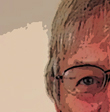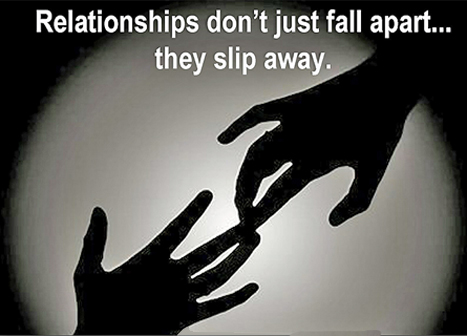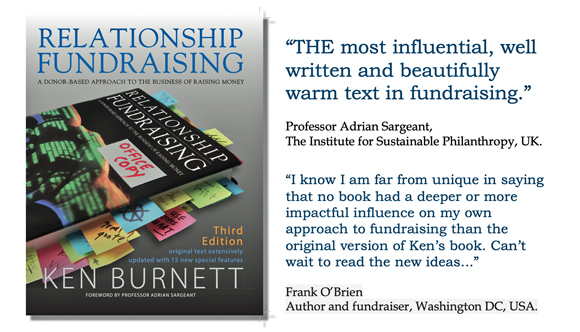|
Blog 7 July 2014. Over the last five years Home page.
|
Even more than two decades ago, in its earliest iteration, most fundraisers could see that relationship fundraising – a donor-based approach to the business of raising money – was simply the right thing for us to do. But through those busy, competitive decades putting it into practice proved, for most fundraisers, anything but easy. Now, over the last five years, we’ve learned precisely how to make relationship fundraising work in practice. And we see that, with the right people in the right places doing the right things, a donor-focused approach can drive and inspire the whole organisation, not merely donor communications. But to replicate this effectively throughout our industry, major paradigm shifts are needed.
Recently I was asked to provide a short, pithy quote to go alongside the section in the Institute of Fundraising’s Fundraiser’s Toolkit (2014) that refers specifically to donors. Though neither short nor pithy, I decided to put forward the following.
I’m proud of fundraising and particularly of the huge strides we’ve made to transform it into a competent, qualified, effective profession with high standards. This has irrevocably changed our business from the largely amateur if well-intentioned activity that I joined, back in 1977, into a UK-wide, competitive, efficient industry. But we’ve still a long way to go before we can say with hand on heart that our donors are comfortable with how we do what we do; that we’re leading them effectively and enthusiastically into the full potential of their charitable giving. Rather the opposite; we’re losing too many of them much too quickly and failing to attract many more that should be with us for the long term. In our rush to professionalise I fear too many fundraisers have overlooked, or not been properly inducted into, the values that must run visibly through our voluntary sector DNA. We’re in the inspiration business and if the people we need to inspire are to believe in, trust and follow us then it’s clear that some big things have to change. This, I’ve come to realise, will require our sector to abandon some of the commercial apparel with which we’ve so recently clothed ourselves. Instead we have to separate our mindsets as well as our actions from the cut and thrust of traditional commerce. We can’t market our way into the hearts, minds and wills of our donors. Perhaps the biggest collective mistake our sector’s made was to talk about charity marketing at all. Donors don’t want to be marketed at. Rather, we need a different paradigm, upon which to build a more durable and mutually beneficial relationship. One based on shared emotions, truth and commitment; on us giving as much as we take, adding meaning, fulfilment, pleasure and satisfaction mixed with the passionate, sincere promotion of the noble act of making a difference for others in need. The commercial transactions that fuel voluntary action have to be seen by all as the outcome of relationship building, not the purpose. Fundraising has, always, to be the means to an end, not the end in itself. The secrets of successful relationship fundraising centre upon the seven pillars of great fundraising from the Proud to be a Fundraiser Toolkit. They’re not rocket science nor are they very surprising, but they’re the ingredients most organisations seem to find difficult to get in place. It’s their absence or ineffectiveness that prevents relationship fundraising from working its magic. 1. Inspirational leadership 2. Building unity around an ambitious dream and a robust emotional heart 3. Commitment to bold investment 5. Storytelling: communicating the truth powerfully and well So important is this, my latest (and, to date, most important) book takes transformational storytelling as its theme. See opposite. I can’t think of a more useful and rewarding skill for any fundraiser to acquire, if he or she aspires to really make a difference, to change the world. Continued at column two, above top.
Joanne Dunsford, Global director of fundraising
|
Continuing from column one, below. 6. Inspiration 7. Getting through I’d like to add two more pillars here, that I think are also vital if relationship fundraising is to be effective: 8. World-class donor service. 9. Lifetime value. So, goodbye acquisition, retention and development Fundraisers won’t truly prosper long term if they’re more famed for intrusion and irritation than for innovation and inspiration. If we would stop people randomly in the street, at work, or on their doorsteps we have to excite and engage them, not ‘turn our high streets into an unwelcome gauntlet of bolshie bucket-shakers and clipboard-waving connivers’, as one UK-government minister described professional fundraisers recently. Even if at least partially inaccurate, it’s a perception we can do without. So there you have it. The signs of an urgent need for change are all around us. We can now show, undeniably, that we know how relationship fundraising should be done to make it work. Which is great news for donors and fundraisers too. Except that, as a result, all we have to do now is to completely revolutionise just about everything we do. I’d love to think that, as a sector, we have the appetite for it. © Ken Burnett 2014 For more on the kind of leadership required see the Revolutionise special report on Great Fundraising, available here.
Ken Burnett is co-founder of Revolutionise (formerly Clayton Burnett Limited), a director of The White Lion Press Limited, a consultant to The Burnett Works agency, former chairman of the board of trustees for the international development charity ActionAid International and is currenty an independent trustee of the UK Disasters Emergency Committee. He’s author of several books including Relationship Fundraising and The Zen of Fundraising and is managing trustee of SOFII, The Showcase of Fundraising Innovation and Inspiration. He is also a commissioner on the newly appointed Commission on the Voluntary Sector and Ageing. His latest book, to be published in September, is Storytelling Can Change the World.
Related articles include
|




